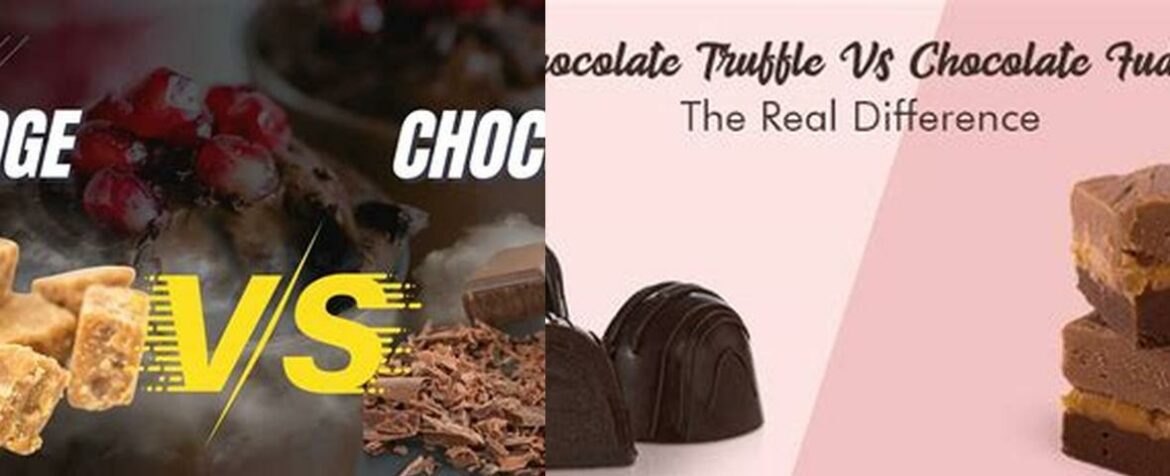Difference Between Fudge And Chocolate – Indulging in the world of sweets is always a treat, and nothing satisfies our cravings quite like chocolate and fudge. But have you ever wondered what sets these two delectable delights apart? Prepare to embark on a mouthwatering journey as we unravel the sweet symphony of differences between fudge and chocolate. From their distinct textures to their unique flavor profiles, we’ll explore the nuances that make these treats a delightful part of our lives. So, grab a cup of cocoa and get ready to dive into the delicious depths of fudge and chocolate.
Chocolate and Fudge: Unveiling the Sweet Symphony of Differences
In the realm of delectable confections, chocolate and fudge stand as two beloved treats, each captivating taste buds with its distinct charm. While often mistaken for one another, these sugary delights possess unique characteristics that set them apart, offering a diverse symphony of flavors and textures.
Deconstructing the Essence of Chocolate
Chocolate, a culinary masterpiece crafted from the finest cocoa solids, cocoa butter, and sugar, tantalizes the senses with its velvety texture and captivating flavor. This versatile delicacy comes in various forms, from the rich indulgence of dark chocolate to the milky sweetness of milk chocolate and the ethereal smoothness of white chocolate. Beyond its gustatory appeal, chocolate boasts potential health benefits, attributed to its abundance of antioxidants and essential minerals.
Unveiling the Enigmatic Allure of Fudge
Fudge, an equally enticing confection, emerges from a harmonious blend of sugar, butter, milk or cream, and an array of flavorings, resulting in a velvety and creamy texture that melts in the mouth. This delectable treat finds its roots in classic flavors like chocolate and vanilla, while also venturing into creative variations that ignite the imagination. Whether savored alone or as an exquisite topping, fudge captivates with its rich, bold flavors and satisfying chewiness.
Illuminating the Key Distinctions
While chocolate and fudge share the common ground of sweetness, their paths diverge in terms of ingredients, preparation, texture, and culinary applications.
Ingredients: A Tale of Two Compositions
Fudge distinguishes itself from chocolate by incorporating additional components like sugar, butter, and milk, which contribute to its distinctive flavor and texture. In contrast, chocolate relies primarily on cocoa solids and cocoa butter, giving it a more pronounced cocoa flavor.
Preparation: A Culinary Odyssey
The journey from raw ingredients to delectable treat unfolds differently for fudge and chocolate. Fudge undergoes a meticulous cooking process at a higher temperature, coaxing it into its characteristic creamy texture. Meanwhile, chocolate embarks on a molding or shaping odyssey, transforming into various forms that delight the eye and palate.
Texture and Consistency: A Symphony of Sensations
Chocolate enchants with its smooth and creamy texture, a testament to the velvety embrace of cocoa butter. Fudge, on the other hand, boasts a denser, grainy texture, a result of the harmonious interplay between sugar, butter, and milk. When it comes to melting, chocolate surrenders gracefully, dissolving softly on the tongue. Fudge, however, exhibits a more resilient nature, taking its time to melt, teasing the taste buds with its lingering presence.
Sweetness and Flavor Intensity: A Dance of Flavors
Chocolate typically strikes a balance between sweetness and a mild flavor, often enhanced with additional ingredients to create a symphony of taste sensations. Fudge, in contrast, exudes a bolder flavor and chewier texture, leaving an unforgettable impression on the palate.
Culinary Canvas: A World of Possibilities
Chocolate’s versatility knows no bounds, gracing desserts, beverages, and even savory dishes with its presence. From decadent cakes and luscious mousses to rich hot chocolate and exotic sauces, chocolate weaves its magic across culinary landscapes. Fudge, while often enjoyed as a luxurious snack on its own, also finds its way into desserts, adding a touch of indulgence and delight.
In Conclusion: A Matter of Personal Preference
Chocolate and fudge, while sharing the realm of sweet treats, offer distinct taste experiences and textures, catering to diverse palates and preferences. Chocolate, with its endless possibilities and adaptability, appeals to those seeking a versatile ingredient that can transform any culinary creation. Fudge, with its traditional recipes and bold flavors, captivates those who appreciate the comfort and familiarity of classic confections. Ultimately, the choice between chocolate and fudge rests upon the individual’s palate, a personal journey of discovery and indulgence.
FAQ about the Difference Between Fudge and Chocolate
Q: What are the main differences between fudge and chocolate?
A: Fudge and chocolate are distinct confections with different characteristics. While chocolate is made from cocoa solids, cocoa butter, and sugar, fudge is typically made from sugar, butter, and milk or cream.
Q: How does the texture of chocolate differ from fudge?
A: Chocolate has a smooth and velvety texture, while fudge has a dense and creamy texture.
Q: Are there different types of chocolate available?
A: Yes, there are various types of chocolate, including dark chocolate, milk chocolate, and white chocolate, each with its own unique flavor profile.
Q: Does chocolate have any health benefits?
A: Yes, chocolate, especially dark chocolate, is known for its potential health benefits due to its high antioxidant content and essential minerals.
Q: What is fudge made of?
A: Fudge is typically made from a combination of sugar, butter, and milk or cream, which is heated and then cooled to create its distinctive texture.
Q: Can fudge be made with different flavors or add-ins?
A: Yes, fudge can be made with various flavors and add-ins, such as nuts, fruits, or even marshmallows, allowing for a wide range of delicious variations.


